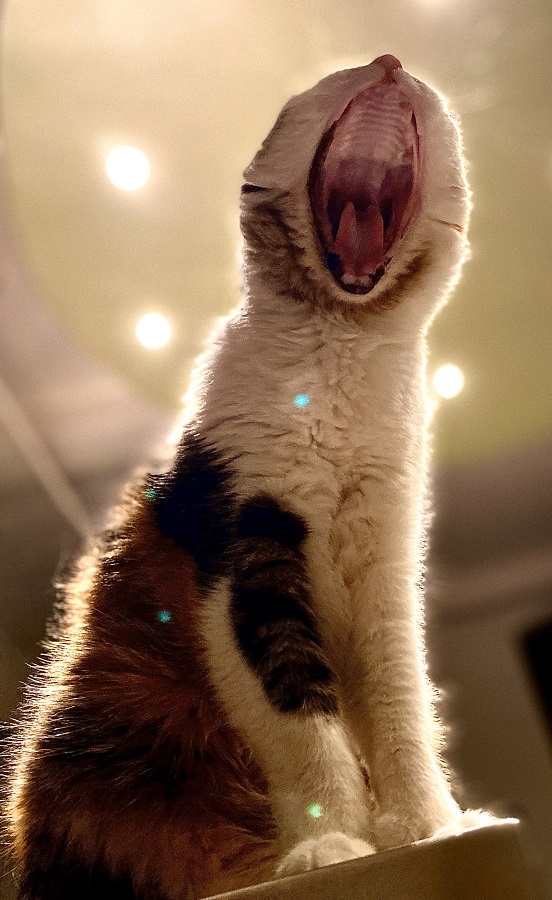
Upper Respiratory Infections in Cats / Feline URI

Few things are more frustrating and irritating for humans than the common cold. The sneezing, the congestion, the runny nose, and the watery eyes can make us truly miserable. Unfortunately, our feline counterparts can relate; they, too, can fall victim to this annoying malady. In cats, we tend to be a little more technical with the terminology, preferring to call the condition an upper respiratory infection (URI) as opposed to a “cold”. Although bacteria and fungi can cause URIs in cats, by far the most common cause of URIs in cats is viral. The primary culprits are the feline herpes virus (FHV) and the feline calici virus (FCV). These two viruses account for about 80% of all kitty URIs. The most popular way that cats acquire a URI is by coming into contact with another cat that has a URI, especially if the other cat is sneezing a lot, as the respiratory viruses become aerosolized and are easier to inhale. Inanimate objects, such as an infected food bowl or water bowl, are another method of transmission, as is contact with human hands that have touched an infected cat. As you might have noticed, these conditions are rampant in shelters and catteries, and every such facility has grappled with an outbreak of URI at one time or another. Kittens, with their weak immune systems, are very susceptible to URIs, often being exposed to the virus via nursing, around the time of weaning.
SEE ALSO: Household Hazards for Cats
Once exposed to the virus, there is an incubation period lasting two to five days. Clinical signs then develop. The most common signs include sneezing, conjunctivitis (inflamed tissues around the eyes), nasal discharge, congestion, lethargy, decreased appetite, and possibly fever. Many cat owners report a change in their cat’s meow, describing it as being more hoarse or even silent, or that the purr sounds more raspy. Corneal ulcers may develop, especially in cats infected with the herpes virus. Ulcers in the mouth and on the tongue are a hallmark of calici virus infection. These ulcers, if present, cause significant discomfort for the cat and affected cats will often stop eating and will drool excessively.
Your veterinarian will make the diagnosis of URI based mainly on clinical signs. There’s no need to determine exactly which virus(es) are responsible, since treatment is symptomatic regardless. Antibiotics are often administered with the goal of preventing a secondary bacterial infection from occurring. As with colds in humans, cats often recover on their own, usually in five to 14 days. More severe cases might require additional measures. For example, cats with corneal ulcers or very inflamed eyes might require topical eye drops or ointments. Very congested cats that cannot smell their food will often have a poor appetite and may require syringe feeding and/or appetite stimulants to keep up their nutrition until the congestion resolves. Although most cats defeat the virus on their own, very stubborn cases may benefit from antiviral medications. These medications tend to be a little pricey, but are pretty effective. Cats with URIs rarely need to be hospitalized.
Once cats become infected, they become carriers of the virus. Herpes viruses in particular are notorious for staying in the body forever, usually lying dormant. During times of stress, when the immune system is suppressed, the virus can re-emerge and cause clinical signs of illness. Some cats seem especially susceptible to this. My 13 year-old cat Mittens has had one URI in her lifetime. My previous cat, Crispy, would come down with a URI approximately twice a year, for her entire life. Every cat is different. Most cats get over their colds, and are perfectly fine for months or years.
Vaccines against viral URIs are available and are routinely given. When we vaccinate cats against the respiratory viruses, it’s not actually to prevent infection. Most cats have already been exposed to the virus during kittenhood and are carriers. Vaccination doesn’t eliminate the carrier status of previously infected cats. However, properly vaccinated cats experience milder symptoms when the virus re-emerges from dormancy.

It should be noted that some cats do not recover uneventfully. Severe viral infections can result in permanent damage to the delicate turbinate bones within the nasal cavity, predisposing the cat to recurrent bacterial infections. These cats are said to have chronic “rhinosinusitis”, inflammation of the nasal cavity and sinuses. These poor cats may have persistent sneezing, continual nasal discharge (either from one nostril, or from both), and chronically congested breathing. I’ve seen these cats in my practice many times. You can hear them breathing from across the room. Most clients bring the cat to me because the cat is having a “flare up”, where their signs are particularly striking. These cats tend to be fine in every other way. Most veterinarians prescribe a short course (7 to 10 days) of antibiotics for these cats, and the majority show clinical improvement, returning the cats to their usual state of sneezy-ness and snuffly-ness. These cats will never be cured, however, with medical management and supportive care, their sneezing, nasal discharge, and congestion can be kept to a minimum, giving these cats an excellent quality of life.
SEE ALSO: Feline Asthma

1 Comment
Norma
Pretty! This has been an extremely wonserful post.Thank you for supplying this info.